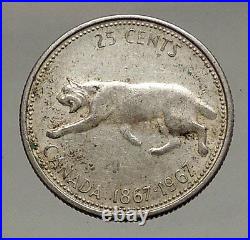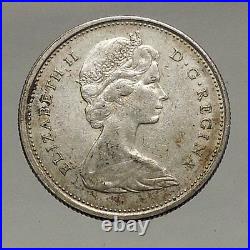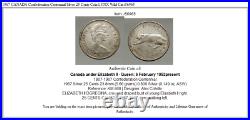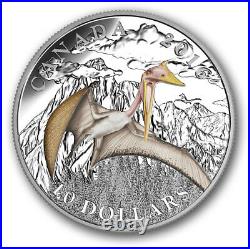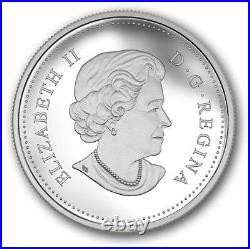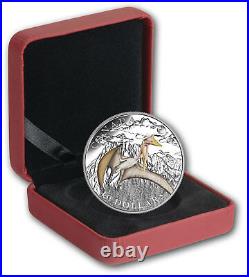Item: i56965 Authentic Coin of. Available for sale in my store. All coins of Canada. The Canada lynx (Lynx canadensis) or Canadian lynx is a North American mammal of the cat family, Felidae. With a dense silvery-brown coat, ruffed face and tufted ears, the Canada lynx resembles the other species of the mid-sized Lynx genus. It is slightly larger than the bobcat, with which it shares parts of its range, and over twice the size of the domestic cat. Was the process by which the federal Dominion of Canada was formed on July 1, 1867. On that day, three British colonies became four provinces of the new dominion. The existing United Province of Canada was divided into the new provinces of Ontario and Quebec , and two other colonies, New Brunswick and Nova Scotia , also became provinces of the new Dominion of Canada. Canada is a federal state and not a confederate association of sovereign states, the usual meaning of confederation ; but is often considered to be among the world’s more decentralized federations. In this Canadian context, confederation generally describes the political process that united the colonies in the 1860s and related events, and the subsequent incorporation of other colonies and territories. The term confederation is now often used to describe Canada in an abstract way, “the Fathers of Confederation ” itself being one such usage. Provinces and territories that became part of Canada after 1867 are also said to have joined, or entered into, confederation (but not the Confederation). Confederation is, loosely translated, a confederation of colonies. The term is also used to divide Canadian history into pre-Confederation i. Pre-1867 and post-Confederation i. Further information: Constitutional history of Canada. Map of North America before the French and Indian War , that is part of the greater world-wide conflict known as the Seven Years’ War (1756 to 1763). Possessions of Britain (pink), France (sky blue), and Spain (green). All the former colonies and territories that became involved in the Canadian Confederation on July 1, 1867, were initially part of New France , and were once ruled by France. Nova Scotia was granted in 1621 to Sir William Alexander under charter by James VI. This claim overlapped the French claims to Acadia , and although the Scottish colony of Nova Scotia was short-lived, for political reasons, the conflicting imperial interests of France and the 18th century Great Britain led to a long and bitter struggle for control. Present-day mainland Nova Scotia was finally acquired by the British by the Treaty of Utrecht of 1713 and the Acadian population was eventually expelled by the British in 1755. They called Acadia Nova Scotia , which included present-day New Brunswick. The rest of New France was acquired by the British by the Treaty of Paris (1763) , which ended the Seven Years’ War. From 1763 to 1791, most of New France became the Province of Quebec. However, in 1769 the present-day Prince Edward Island , which had been part of Acadia, was renamed “St Johns Island” and organized as a separate colony. It was renamed “Prince Edward Island” in 1798 in honour of Prince Edward, Duke of Kent and Strathearn. The first English attempt at settlement had been in Newfoundland , which would not join the Confederation until 1949. The Society of Merchant Venturers of Bristol began to settle Newfoundland and Labrador at Cuper’s Cove as far back as 1610, and Newfoundland had also been the subject of a French colonial enterprise. In the wake of the American Revolution , an estimated 50,000 United Empire Loyalists fled to British North America. The British created the separate colony of New Brunswick in 1784 for the Loyalists who settled in the western part of Nova Scotia. While Nova Scotia (including New Brunswick) received slightly more than half of this influx, many Loyalists also settled in the Province of Quebec, which by the Constitutional Act of 1791 was separated into a predominantly English Upper Canada and a predominantly French Lower Canada. The War of 1812 and subsequent Treaty of 1818 established the 49th parallel as the border with the United States from the Great Lakes to the Rocky Mountains in Western Canada. Canadian Territory at Confederation. Following the Rebellions of 1837 , Lord Durham in his Durham Report , recommended that Upper Canada and Lower Canada should be joined to form the Province of Canada and that the new province should have a responsible government. As a result of Durhams report, the British Parliament passed the Act of Union 1840 , and the Province of Canada was formed in 1841. The new province was divided into two parts: Canada West (the former Upper Canada) and Canada East (the former Lower Canada). Ministerial responsibility was granted by Governor General Lord Elgin in 1848, first to Nova Scotia and then to Canada. In the following years, the British would extend responsible government to Prince Edward Island (1851), New Brunswick (1854), and Newfoundland (1855). The area which constitutes modern-day British Columbia is the remnants of the Hudson’s Bay Company’s Columbia District and New Caledonia District following the Oregon Treaty. Prior to joining Canada in 1871, British Columbia consisted of the separate Colony of British Columbia (formed in 1858, in an area where the Crown had previously granted a monopoly to the Hudson’s Bay Company), and the Colony of Vancouver Island (formed in 1849) constituting a separate crown colony until it was united with the Colony of British Columbia in 1866. Elizabeth II (Elizabeth Alexandra Mary; born 21 April 1926) is, and has been since her accession in 1952, Queen of the United Kingdom, Canada, Australia, and New Zealand, and Head of the Commonwealth. She is also Queen of 12 countries that have become independent since her accession: Jamaica, Barbados, the Bahamas, Grenada, Papua New Guinea, Solomon Islands, Tuvalu, Saint Lucia, Saint Vincent and the Grenadines, Belize, Antigua and Barbuda, and Saint Kitts and Nevis. Elizabeth was born in London to the Duke and Duchess of York, later King George VI and Queen Elizabeth , and was the elder of their two daughters. She was educated privately at home. Her father acceded to the throne on the abdication of his brother Edward VIII in 1936, from which time she was the heir presumptive. In 1947, she married Prince Philip, Duke of Edinburgh , with whom she has four children: Charles , Anne , Andrew , and Edward. Elizabeth’s many historic visits and meetings include a state visit to the Republic of Ireland and reciprocal visits to and from the Pope. She has seen major constitutional changes, such as devolution in the United Kingdom, Canadian patriation , and the decolonisation of Africa. She has also reigned through various wars and conflicts involving many of her realms. She is the world’s oldest reigning monarch as well as Britain’s longest-lived. In 2015, she surpassed the reign of her great-great-grandmother, Queen Victoria , to become the longest-reigning British monarch and the longest-reigning queen regnant in world history. Times of personal significance have included the births and marriages of her children, grandchildren and great grandchildren, her coronation in 1953 , and the celebration of milestones such as her Silver , Golden and Diamond Jubilees in 1977, 2002, and 2012, respectively. Moments of sadness for her include the death of her father, aged 56; the assassination of Prince Philip’s uncle, Lord Mountbatten ; the breakdown of her children’s marriages in 1992 (her annus horribilis); the death in 1997 of her son’s former wife, Diana, Princess of Wales ; and the deaths of her mother and sister in 2002. Elizabeth has occasionally faced republican sentiments and severe press criticism of the royal family , but support for the monarchy and her personal popularity remain high. Canada is a country, consisting of ten provinces and t hree territories , in the northern part of the continent of North America. It extends from the Atlantic to the Pacific and northward into the Arctic Ocean, covering 9.98 million square kilometres (3.85 million square miles) in total, making it the world’s second-largest country by total area and the fourth-largest country by land area. Canada’s common border with the United States forms the world’s longest land border. Canada is sparsely populated overall, the majority of its land territory being dominated by forest and tundra as well as the mountain range of the Rocky Mountains ; about four-fifths of the population live near to the southern border. The majority of Canada has a cold or severely cold winter climate, but southerly areas are warm in summer. The land now called Canada has been inhabited for millennia by various Aboriginal peoples. Beginning in the late 15th century, British and French colonies were established on the region’s Atlantic coast. As a consequence of various conflicts , the United Kingdom gained and lost North American territories until left, in the late 18th century, with what mostly comprises Canada today. Pursuant to the British North America Act , on July 1, 1867, three colonies joined to form the autonomous federal Dominion of Canada. This began an accretion of provinces and territories to the new self-governing Dominion. In 1931, Britain granted Canada near total independence with the Statute of Westminster 1931 and full sovereignty was attained when the Canada Act 1982 severed the vestiges of legal dependence on the British parliament. Canada is a federal parliamentary democracy and a constitutional monarchy , Queen Elizabeth II being the current head of state. The country is officially bilingual at the federal level. It is one of the world’s most ethnically diverse and multicultural nations, the product of large-scale immigration from many countries, with a population of approximately 35 million as of 2015. Its advanced economy is the eleventh largest in the world , relying chiefly upon its abundant natural resources and well-developed international trade networks. Canada’s long and complex relationship with the United States has had a significant impact on its economy and culture. Canada is a developed country and one of the wealthiest in the world, with the tenth highest nominal per capita income globally, and the eighth highest ranking in the Human Development Index. It ranks among the highest in international measurements of government transparency, civil liberties, quality of life, economic freedom, and education. Canada is a Commonwealth Realm member of the Commonwealth of Nations , a member of the Francophonie , and part of several major international and intergovernmental institutions or groupings including the North Atlantic Treaty Organization , the G8 , the Group of Ten , the G20 , the North American Free Trade Agreement and the Asia-Pacific Economic Cooperation forum. Frequently Asked Asked Questionsns. What is a certificate of authenticity and what guarantees do you give that the item is authentic? Is there a number I can call you with questions about my order? When should I leave feedback? Once you receive your order, please leave a positive. Please don’t leave any negative feedbacks, as it happens many times that people rush to leave feedback before letting sufficient time for the order to arrive. The matter of fact is that any issues can be resolved, as reputation is most important to me. My goal is to provide superior products and quality of service. The item “1967 CANADA Confederation Centennial Silver 25 Cents Coin LYNX Wild Cat i56965″ is in sale since Friday, July 22, 2016. This item is in the category “Coins & Paper Money\Coins\ Canada\Twenty-Five Cents”. The seller is “highrating_lowprice” and is located in Rego Park, New York. This item can be shipped worldwide.
- Country/Region of Manufacture: Canada
- Certification: Uncertified
- Circulated/Uncirculated: Circulated
- Denomination: Denomination_in_description
- Year: Year_in_description

